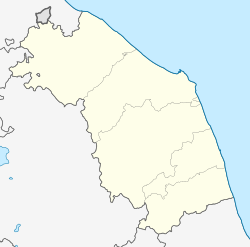Mondolfo | |
|---|---|
| Comune di Mondolfo | |
 | |
 Mondolfo within the Province of Pesaro-Urbino | |
| Coordinates: 43°45′N 13°6′E / 43.750°N 13.100°E | |
| Country | Italy |
| Region | Marche |
| Province | Pesaro e Urbino (PU) |
| Frazioni | Marotta, Molino Vecchio, Ponterio, Sterpettine, Centocroci, Valle del Pozzo |
| Area | |
| • Total | 22.82 km2 (8.81 sq mi) |
| Elevation | 144 m (472 ft) |
| Population (31 December 2017)[2] | |
| • Total | 14,280 |
| • Density | 630/km2 (1,600/sq mi) |
| Demonym | Mondolfesi |
| Time zone | UTC+1 (CET) |
| • Summer (DST) | UTC+2 (CEST) |
| Postal code | 61037 |
| Dialing code | 0721 |
| Website | Official website |
Mondolfo is a comune (municipality) in the Province of Pesaro e Urbino in the Italian region Marche, located about 35 kilometres (22 mi) northwest of Ancona and about 25 kilometres (16 mi) southeast of Pesaro, on the Adriatic Sea.
Mondolfo borders the following municipalities: Castel Colonna, Fano, San Costanzo, Senigallia, Trecastelli. It is one of I Borghi più belli d'Italia ("The most beautiful villages of Italy").[3]
History[edit]
Human presence is testified by remains from as early as the Neolithic Age. However, the first stable settlement appeared starting from the early 11th century, around a Byzantine castle existing here in the 6th-7th centuries.
Main sights[edit]
- Church of San Gervasio
- Sant'Agostino church (1586–93) and convent (17th century)
- Santa Giustina church (completed around 1760)
- San Sebastiano (1479), housing the Ceccarini altarpiece
- Church of San Giovanni (17th century)
- Palazzo Giraldi Della Rovere (16th century)
- Palazzo Peruzzi (16th century)
- Sanctuary of the Madonna delle Grotte (1682)
References[edit]
External links[edit]



Well, that’s interesting to know that Psilotum nudum are known as whisk ferns. Psilotum nudum is the commoner species of the two. While the P. flaccidum is a rare species and is found in the tropical islands. Both the species are usually epiphytic in habit and grow upon tree ferns. These species may also be terrestrial and grow in humus or in the crevices of the rocks.
View the detailed Guide of Psilotum nudum: Detailed Study Of Psilotum Nudum (Whisk Fern), Classification, Anatomy, Reproduction